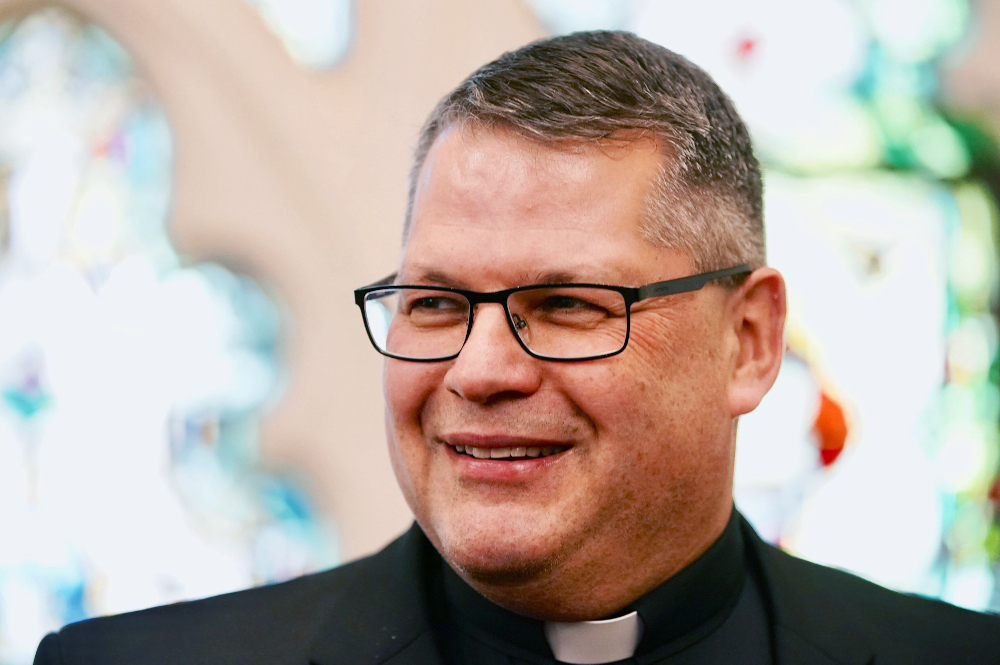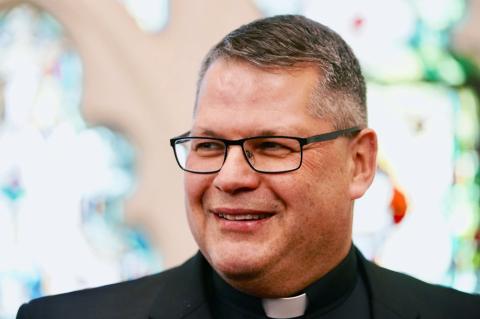
Bishop Douglas J. Lucia of Syracuse, N.Y., is seen in this June 4, 2019, file photo (CNS/Catholic Sun/Chuck Wainwright)

Bishop Douglas J. Lucia of Syracuse, N.Y., is seen in this June 4, 2019, file photo (CNS/Catholic Sun/Chuck Wainwright)
The Diocese of Syracuse has filed for reorganization under Chapter 11 of the U.S. Bankruptcy Code, citing the financial implications of more than 100 lawsuits alleging past child sexual abuse as well as the economic impact of the coronavirus pandemic.
"From the start of my ministry among you, it has been my intent to make reparation to all of the victims of sexual abuse for acts perpetrated against them by clergy, employees or volunteers of the Diocese of Syracuse," Bishop Douglas J. Lucia wrote in a June 19 letter to the faithful.
"However, the growing number of CVA (Child Victims Act) lawsuits against the diocese," he wrote, "presents a risk that those claimants who filed suits first or pursued their claims more aggressively would receive a much greater portion of the funds available to pay victims, leaving other claimants (potentially, even some who have suffered more) with little or nothing.
"In order to ensure that victim claims are treated justly and equitably, I feel it is necessary to enter into Chapter 11 where available funds will be allocated fairly among all victims in accordance with the harm each suffered."
Filing for Chapter 11 is a voluntary action taken by an entity to reorganize financially with the goals of being able to respond to financial claims and to emerge with its operations intact, the diocese explained in an FAQ; this filing also immediately stops all efforts at debt collection and legal actions against the entity.
Only the corporation of the Roman Catholic Diocese of Syracuse is filing Chapter 11, the FAQ notes. Diocesan parishes; the Foundation, including the HOPE Appeal; Catholic Charities; Catholic schools; the Syracuse Diocesan Investment Fund; the Catholic Sun; and all other separately incorporated funds and entities associated with the diocese are not directly involved in the proceedings.
The Diocese of Syracuse filed its petition with the U.S. Bankruptcy Court for the Northern District of New York early in the morning of July 19, and representatives appeared for a hearing before Chief Judge Margaret Cangilos-Ruiz at 9:30 a.m.
Lucia was accompanied by Danielle Cummings, chancellor and director of communications; Stephen Breen, chief financial officer; and Stephen Donato, Charles Sullivan, and Stephen Helmer, attorneys representing the diocese.
According to its petition, the Diocese of Syracuse has 100 to 199 creditors, estimated assets of $10,000,001 to $50 million, and estimated liabilities of $50,000,001 to $100 million. Its list of creditors with the 20 largest unsecured claims includes 19 individuals (whose names are redacted) with claims identified as Child Victims Act lawsuits; each claim is estimated at $100,000.
The Diocese of Syracuse is the third diocese in New York to file for Chapter 11 since the 2019 Child Victims Act opened a one-year "look-back" window allowing claims of child sexual abuse previously beyond the statute of limitations to be filed.
The Diocese of Rochester filed its Chapter 11 petition Sept. 12, 2019, and the Diocese of Buffalo filed Feb. 28, 2020. The Diocese of Syracuse is the 24th U.S. diocese (following six archdioceses and 17 dioceses) to file for Chapter 11 since 2004. Many of them have since emerged from bankruptcy.
A day after the window opened, 19 suits had been filed against the diocese; by Sept. 12, 23 had been filed. At that time, the diocese said it did not anticipate pursuing reorganization under Chapter 11 and would continue to evaluate options as the year progressed.
As of the bishop's June 19 letter, however, "the Diocese has over 100 lawsuits pending against it. This number could grow, especially in view of the fact that the CVA window is expected to be extended."
The claims brought under the long-back claims law are separate from those settled through the diocese's 2018 voluntary Independent Reconciliation and Compensation Program.
The majority of the claims filed against the diocese under the CVA "involve victims previously unknown to the diocese," the diocese's FAQ said, and "all claims of abuse are decades old, dating back from 1950 to the early 1990s," Lucia wrote.
Lucia's letter noted that filing for reorganization "will require the Diocese to be under court supervision in its Chapter 11 case for many months."
Working with its attorneys, the diocese will create a reorganization plan "detailing how its available assets will be used to pay claims and negotiate reasonable settlements."
As part of that plan, "the diocese intends to create a fund with a pool of money from both diocesan funds and money from insurance carriers"; any restricted donations — including those to the annual HOPE Appeal and the Cathedral Restoration Fund — will not be used to pay legal settlements, according to the FAQ.
While there is no set schedule for the reorganization, the diocese said its "hope is to bring this to a conclusion as soon as possible."
The bishop concluded his letter with an apology and a request for prayer and action.
"It is my hope that during this process of reorganization and following its completion, we will continue to pray for the healing of those who had been harmed during this very dark chapter of the church," Lucia said.
"As your bishop, I must again apologize for these heinous acts and ask you all to join me in our diocesan commitment that these acts will never take place again," he said. "In this matter, we place ourselves under the loving care of the Sacred Heart of Jesus praying that He will make our hearts more like His through this time of purification and reparation."
Advertisement




